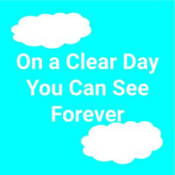
Overview
Synopsis
A kooky young New Yorker, Daisy Gamble, visits a psychiatrist, Dr. Mark Bruckner, to get help in kicking her smoking habit in order to please her fiancé, Warren. However, Daisy is no ordinary patient. She has some unusual powers, such as hearing phones before they ring and making flowers grow just by talking to them. Under hypnosis, she reveals that she can regress into the past and unknowingly becomes Melinda Welles, an English lady from the eighteenth-century. Dr. Bruckner becomes increasingly obsessed about finding out more about Melinda and slowly realizes that he is falling in love with her…Melinda, not Daisy. Meanwhile, Daisy is completely unaware of her eighteenth-century alter-ego and grows fond of Dr. Bruckner. When Daisy discovers the reason for his interest in her, she is horrified and tries to leave. However, she finds herself drawn back to Dr. Bruckner and finally realizes how special she truly is.
Show Information
Context
This guide is to the original 1965 musical, which is currently available for license. The 2011 Broadway revival of the show saw a revised version of the show, with Daisy Gamble reimagined as a gay florist (David), who was a female jazz singer (Melinda) in a former life. The character was split and played by two different actors and incorporated music from the original musical and the film version.
to read the context for On a Clear Day You Can See Forever and to unlock other amazing theatre resources!Plot
Characters
| Name | Part Size | Gender | Vocal Part |
|---|---|---|---|
|
Lead |
Female |
Mezzo-Soprano |
|
|
Lead |
Male |
Baritone |
|
|
Supporting |
Male |
Non-singer |
|
|
Supporting |
Male |
Tenor |
|
|
Supporting |
Male |
Baritone, Tenor |
|
|
Supporting |
Female |
Soprano, Mezzo-Soprano, Alto |
|
|
Featured |
Female |
Non-singer |
|
|
Featured |
Male |
Tenor, Baritone |
|
|
Featured |
Female |
Non-singer |
|
|
Featured |
Male |
Tenor, Baritone, Bass-Baritone |
|
|
Featured |
Female |
Soprano, Mezzo-Soprano, Alto |
|
|
Featured |
Male |
Non-singer |
|
|
Featured |
Male |
Tenor, Baritone |
|
|
Featured |
Female |
Non-singer |
|
|
Ensemble |
Either Gender |
Soprano, Mezzo-Soprano, Alto, Tenor, Baritone, Bass, Bass-Baritone |
Songs
Act One
- "Hurry! It's Lovely Up Here!" - Daisy
- “First Regression” - Mark
- "Solicitor’s Song" - Solicitor, Trundle, Hubert, Insdale, and Welles.
- "He Wasn’t You" - Daisy
- "On a Clear Day (You Can See Forever)" - Mark
- " * On the S.S. Bernard Cohn" - Daisy, Muriel, Sally, and Patty
- "She Wasn't You" - Edward and Melinda
- "Melinda" - Mark
Act Two
- "When I Come Round Again" - Preston and Students
- "What Did I Have That I Don't Have?"- Daisy
- "Wait Till We're Sixty-Five" - Warren and Daisy
- "Come Back to Me" - Mark
- "Come Back to Me [Reprise]" - Mark
A song with an asterisk (*) before the title indicates a dance number; a character listed in a song with an asterisk (*) by the character's name indicates that the character exclusively serves as a dancer in this song, which is sung by other characters.
Monologues
Scenes
Key Terms
Sorry! We do not currently have terms for this guide.
Videos
Quizzes
Themes, Symbols & Motifs
Sorry! We do not currently have learning modules for this guide.
Quote Analysis
Sorry! We do not currently have learning modules for this guide.
